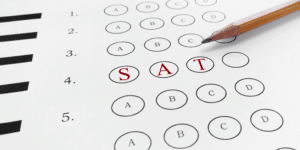If you’re planning on taking the SAT, you may have heard about the mysterious “5th section” of the exam. This section is known as the experimental section, and it’s included in the test solely for the purpose of testing out new questions and gauging their difficulty level. While it doesn’t count towards your final score, it’s still an important part of the SAT, and understanding it can help you approach the exam with greater confidence.
In this blog post, we’ll take a closer look at the SAT 5th section and what you need to know about this experimental section of the exam. We’ll explore the history of the 5th section, how it’s used to pretest content, and why it’s important to take it seriously. We’ll also provide tips and strategies for approaching the 5th section and making the most of this opportunity to improve your SAT performance. So whether you’re a seasoned test-taker or getting ready to take the SAT for the first time, read on to learn more about the experimental SAT 5th section.
An Overview of the SAT Sections
The SAT (Scholastic Assessment Test), sometimes known to high schoolers across the United States as the “big test,” is a standardized test consisting of four primary sections: Reading, Writing, and Language, Math with no calculator, and Math with calculator.
The Reading section evaluates reading comprehension abilities, while the Writing and Language section assesses grammar rules, usage, and punctuation proficiency. The Math sections measure mathematical skills, with one section allowing calculator use and the other not. And just to keep students on their toes, some tests even have a 5th top-secret section that to many test-takers is a total mystery. But fear not, we have you covered with everything you need to know about the 5th Section of the SAT.
What Is the 5th Section of the SAT?
The 5th section of the SAT, also known as the SAT variable section, is a experimental SAT section that lasts 20 minutes and focuses on a specific content area like Reading Comprehension, Writing and Language, or Mathematics.
This section is used to try out new questions that may appear on future exams, so it’s important for the College Board to see how well students respond to them. Think of it as a sneak peek into what’s to come in the world of standardized testing!
Why Is There a 5th Section on the SAT?
The main purpose of the 5th section is to test out new questions and see how well students perform on them. This helps the College Board determine which questions are fair, reliable, and valid for use on future exams.
By testing out new questions on a small group of students, they can get a sense of how well these questions work and whether they should be included on future SATs. In other words, the 5th section is all about making sure the SAT is as accurate and reliable as possible!
What Types of Questions Are On the Experimental Section of the SAT?
Since the 5th section of the SAT is an optional section that does not count toward the overall score and is only used by the College Board to test out new questions and assess their difficulty levels, the types of questions that might appear on this section can vary widely.
However, one example of a type of question that might appear on the 5th section of the SAT is a complex math problem that requires multiple steps to solve. These questions might involve concepts such as calculus, trigonometry, or advanced algebra, and may require students to use multiple formulas or equations to arrive at the correct answer. Alternatively, the 5th section might include a set of reading comprehension questions that focus on a particularly difficult or dense passage, requiring students to use advanced analytical and critical thinking skills to answer the questions. Below is an example of a reading comprehension question you might encounter on the 5th section of the SAT:
Passage:
In the early 20th century, women in many parts of the world were fighting for their right to vote. One such woman was Alice Paul, who was born in New Jersey in 1885. Paul was a suffragist and feminist who dedicated her life to securing women’s right to vote. She led several protests and picket lines in Washington D.C. and was instrumental in the passage of the 19th Amendment to the U.S. Constitution, which gave women the right to vote in 1920.
Question:
What is the main idea of the passage?
A. Alice Paul was a feminist and suffragist who was born in New Jersey.
B. Women in the early 20th century fought for their right to vote.
C. Alice Paul led protests and picket lines in Washington D.C.
D. The 19th Amendment to the U.S. Constitution gave women the right to vote.
In this example of a reading comprehension question found on the 5th section of the SAT, the correct answer would be B because the passage discusses the broader context of women’s suffrage movement and the fight for women’s right to vote in the early 20th century, not just Alice Paul’s role in it.
Does Every SAT Contain a 5th Section?
If you’re worried about whether or not you’ll face a 5th Section when you take the SAT, know that not every SAT actually has a 5th section; whether or not you need to complete this part of the exam is completely random and is determined by the College Board.
However, since the questions on the 5th section are not used to calculate your final score, the College Board doesn’t need to include it on every SAT. If you do get one, it will be in addition to the regular 4 sections of the SAT and will be 20 minutes long – so prepare accordingly!
Does Section 5 on the SAT Count in 2024?
The good news is that not only is the 5th section completely optional for test-takers, it also doesn’t affect your score on the actual exam (but it’s still a good idea to take it seriously and do your best). Although the College Board hasn’t definitively stated that Section 5 won’t count towards your score, there’s never been a recorded instance of a question from this section appearing in the scored Question-and-Answer Service sections.
While Section 5 of the SAT may seem pointless and unnecessary to prospective test-takers, rest assured that it’s all just a part of the SAT’s quality assurance process – Section 5 is there to help the College Board test out new material and make future tests even better.
Read More: How To Check Your SAT Score: A Step by Step Guide
Want To Get The Highest Score Possible On The SAT?
How To Prepare for Section 5 of the SAT
Preparing for the experimental 5th section of the SAT can be a bit of a challenge, but don’t worry – we’ve got you covered! The 5th section is designed to test out new material and question types, so it’s unlikely that you’ll see anything on it that isn’t already covered in the other sections of the test. That means that the best way to prepare for the 5th section is to focus on mastering the content covered in the other sections, which is totally doable with some hard work and practice.
To prepare for the 5th section, we recommend taking as many practice tests as possible. Don’t worry – this isn’t about memorizing answers or cramming for the test! Practice tests will help you become familiar with the format and content of the SAT, as well as the types of questions you’re likely to see on the test.
By taking your time and focusing on building your test-taking skills, you’ll be better equipped to tackle whatever the SAT throws at you. And who knows? You may even discover some new strategies that can help you in school, college, or beyond. So take a deep breath, grab a study buddy, and let’s get started on acing not just the 5th section, but the entire SAT!
Related SAT Resources:
- Upcoming 2023 SAT Test Dates & Deadlines
- How Much is the SAT? An Overview of Fees and Registration Costs
- What’s a Good SAT Score for 2023?
- Must Know SAT Grammar Rules for 2023
- Choosing Between Taking the SAT and the ACT
- An Overview of the SAT and SAT Test Prep
- SAT Prep and Khan Academy: What They Won’t Tell You
- 100 Ways To Increase Your Score on the SAT
- The Best Ways To Prepare Yourself for the SAT and ACT




